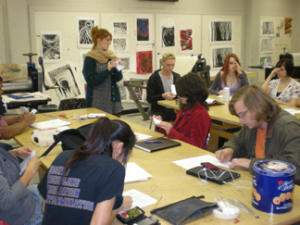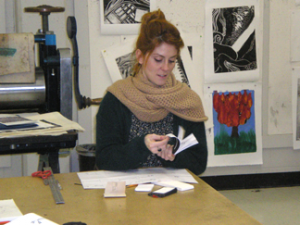By Kelli Henderson/entertainment editor
Having lived in Spain her whole life and visited the U.S. only once before in 2010, artist Carla Nicolás packed her bags for a week and headed to South Campus.

Kelli Henderson/The Collegian
She is presenting her Graphic Mutations: From Book to Object exhibition in the Carillon Gallery through Feb. 9.
The petite artist, with raven hair and all smiles, was offered a trip here by Joshua Goode, South’s fine arts department chair.
Goode originally met Nicolás at the Pyramid Atlantic Art Center in 2010 at an international printmaking residency program in Washington, D.C.
“I was able to see her work and be introduced with her and was very impressed,” he said. “I knew I needed to find a way to get her to come down here to work with our students so that they could benefit from her knowledge and expertise.”
Although not having any artists in her immediate family, Nicolás said she was always creative as a child.
“Her parents supported her work,” said Erika Duque, translator for Nicolás and participant in TCC’s printmaking residency program.
Nicolás appreciated the support her parents and family showed her.
“I think it’s very important. All people can be artists if you support them,” she said.

Kelli Henderson/The Collegian
Having focused her attention on graphic arts, she completed her studies as an advanced technician in engraving at the Escuela de Arte de Zaragoza in Spain. She worked in metal smithing with metal plates and said she loved the process.
Nicolás said her Graphic Mutations exhibit is a representation of not only her experiences but also the many things she learned here in that month.
“It was a great experience for me, for my personal life and for my artistic ability,” she said.
The daily life of an artist in Spain is different than for an American artist, not only culturally different but artistically as well.
“In Spain, the government gave me a loan to come here. In my city, the government helps extend artists’ studies, and I chose the United States,” Nicolás said. “I like the art [of the U.S.]. It’s

Kelli Henderson/The Collegian
different. The art in Europe is similar in all the countries.”
Nicolás said American artists are passionate about their work, and the art deals more with installations, which Nicolás said she likes. She also enjoys the calm, cool and collected persona Americans like to put on.
“They are very loud and boisterous [in Spain]. For her, it bothers her that everyone is so loud,” Duque said. “Here, we’re more calm and not as talkative.”
Coming to America as an experienced artist and having to interact with American students is not as intimidating as it might sound. Nicolás said she loves sharing with them and loves when they share with her.
“I think it’s very important to not work alone … [It is] fantastic to learn with them and with me,” she said. “I like to work with people. You can learn more.”
South art student Tresa Davis said she has enjoyed her time with Nicolás and never could have imagined she would meet someone from Spain.
Nicolás has also taught the students different techniques to use when creating their art pieces.
“[I enjoyed the technique of] using the water and the salt and then the water again,” she said. “Salt and art? Who would have thought?”
Nicolás doesn’t think she can advise students who struggle with creativity.
“She says she can’t really give advice because she too is progressing as well,” Duque said.
But she can relate to the struggle.
“[Getting stuck] is a problem that all artists have. I think it’s better to stop. Relax. And then, tomorrow, start again,” Nicolás said. “Because sometimes you start a piece and work and finish, and sometimes it’s most difficult.”
When she does finish a piece, Nicolás gets a satisfying feeling. She doesn’t have a specific routine when she starts creating but draws from history and historical references.
“It’s different with each piece,” she said. “Sometimes I see an object and then start to work on the object.”
Nicolás keeps working with pieces.
“She likes to find relationships with objects,” Duque said.
South and SE art student Colton Scally said he feels privileged because in the first two weeks of classes, he has already worked with an artist like Nicolás.
“I like her concepts,” he said. “She challenged me not to be conceptual with [my] next project.”
The Graphic Mutations exhibition at the Carillon Art Gallery is her definition of books. As she does with each piece, Nicolás takes on an object, in this case a book, and transforms it. She changes the form and texture and takes it to a 3-D element.
“Most people would not interpret them as a literal book,” Goode said. “She has taken a lot of liberties in what she calls a book, and they’re very beautiful. She’s created something that will really make students think about their ideas of what art has to be.”

